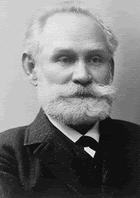 Can you identify the man in the photo to the left?
Can you identify the man in the photo to the left?
Most people probably can’t.
The picture is of Ivan Pavlov a Russian scientist (not a behaviorist) who was studying the digestive system in canines when he noticed that his subjects began to salivate in response to the delivery of food.
Why do I bring this up? Yesterday I enjoyed a stimulating conversation with another seasoned animal trainer.
Although today there are many different options available to those who are interested in animal behavior, “back in the day” we both attended and graduated from the only wild animal training college that existed and when we talk behavior–it is the stuff that would make your head spin.
Just for the record, I believe that training is an art AND a science…but more on that later.
What I want to discuss today is the error that some people are making when they refer to what type of training they are doing with an animal.
We’ve both been coming across domestic animal trainers that are referring to operant conditioning as classical conditioning.
So, let’s talk about classical conditioning and clear up some confusion.
Classical conditioning is the association of a involuntary or reflexive behavior with new stimuli.
Many people have heard about the study that resulted in a bell causing the dogs to salivate.
Initially, the salivation began to occur when his assistants came into the room.
Ivan Pavlov tested this observation by pairing a specific signal (stimulus) to the environmental conditions surrounding the delivery of food.
The dogs then salivated (an automatic response or anatomic response) when that stimulus was presented.
Environmental antecedents (preceding conditions or events) occurring prior to a behavior become classically conditioned.
Basically, most of classical conditioning associations occur naturally, and in some cases, by accident.
In the pet world, you can observe this easily.
Just watch a pet owner grab the leash, if the dog has learned that the leash always means a walk, the response is usually an increase in activity and excitement.
If you watch animals in a zoo, you can see them pacing in front of their night quarters prior to lock up for the night. The antecedent is usually time contingent–but can also be paired with the appearance/presence of the caretaker(s).
These behaviors are triggered and reinforced by the consequences within the environment and by associations made by the animal.
So, Pavlov first noticed that his canine subjects salivated when food was presented but also when his assistants entered the room.
He then tested his theory by creating an association between the ringing of a bell and food.
As his study continued, he found the dogs salivated upon hearing the bell.
His investigation into this phenomena established the laws of classical conditioning.
Above: Classical conditioning video tutorial.
Skinner labeled classical conditioning as “respondent conditioning” since the subject is responding to an environmental antecedent.
Classical or respondent conditioning is a purely behavioral type of learning. Animals or people conditioned in this manner do not consciously learn the associations between the stimuli and the responses.
When you associate a marker with the delivery of a primary reinforcer, such as food, you are using classical conditioning.
Those who use clicker training call this “charging the clicker.”
Now, where things get tricky is that when you are altering behavior, in most cases you are using operant conditioning not classical conditioning.
More later…in the meantime, play the Pavlov dog game.

